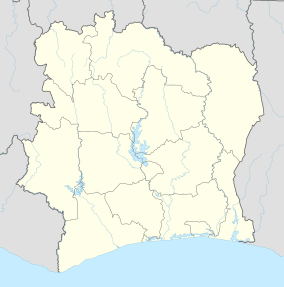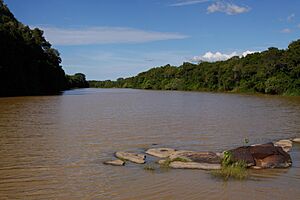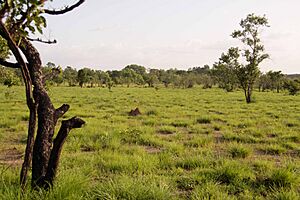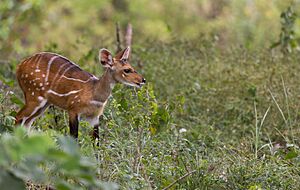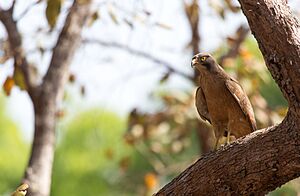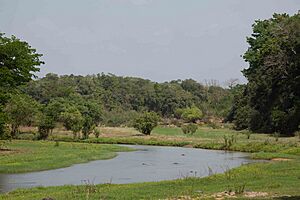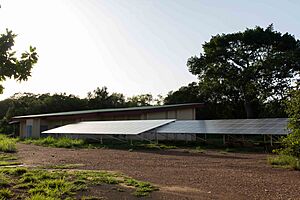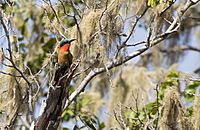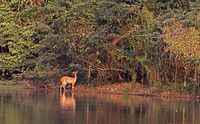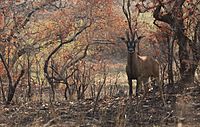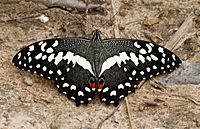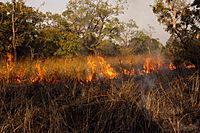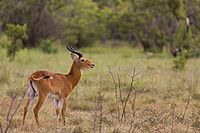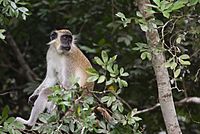Comoé National Park facts for kids
Quick facts for kids Comoé National Park |
|
|---|---|
|
IUCN Category II (National Park)
|
|

Comoé National Park savannah with rainbow
|
|
| Location | Côte d'Ivoire |
| Area | 11,500 km2 (4,400 sq mi) |
| Established | 1983 |
| Type: | Natural |
| Criteria: | ix, x |
| Designated: | 1982 (6th session) |
| Reference #: | 227 |
| Region: | Africa |
| Endangered: | 2003–2017 |
The Comoé National Park (in French: Parc national de la Comoé) is a huge protected area in Côte d'Ivoire, a country in West Africa. It's like a special nature reserve and a UNESCO World Heritage Site. This means it's recognized globally for its amazing natural value.
The park is the largest protected area in all of West Africa. It covers a massive area of 11,500 square kilometers (4,400 sq mi). Imagine a space that big, filled with different types of nature!
What makes Comoé National Park so special is its variety of environments. It stretches from humid, wetter areas in the south to drier areas in the north. This change in climate creates many different homes for plants and animals.
You can find many types of savanna (grasslands with scattered trees), gallery forests (forests along rivers), and even small forest islands. Many rare animal and plant species find their last safe place here.
The park was first named a World Heritage Site because of its diverse plant life, especially the patches of tropical rainforest found near the Comoé River. These rainforests are usually only found much further south.
In 2003, the park was put on a list of World Heritage Sites in Danger. This happened because of poaching (illegal hunting), a lack of management, and too many cattle grazing in the park. These problems got worse during the First Ivorian Civil War.
But there's good news! In 2017, the park was taken off the "in Danger" list. This was because of big improvements in protecting its animals and habitats.
Contents
History of Comoé National Park
The area where Comoé National Park is located was always lightly populated. This was probably because the soil wasn't very good for farming. Also, there were diseases like river blindness and sleeping sickness, which are spread by insects.
In 1926, part of this area was declared a "Refuge Nord de la Côte d'Ivoire" (Northern Refuge of Côte d'Ivoire). This gave it some basic protection. Later, in 1942 and 1953, it was made even bigger and called "Réserve de Faune de Bouna" (Bouna Wildlife Reserve).
On February 9, 1968, the area became a full National Park. It grew to 11,500 square kilometres (4,400 sq mi), making it one of the largest national parks in the world and the biggest in West Africa. In 1983, it was also named a Biosphere Reserve and a UNESCO World Heritage Site because of its amazing variety of life.
As mentioned, the park faced tough times during the First Ivorian Civil War. It was put on the "World Heritage in Danger" list in 2003. This was due to a lack of management, which led to more poaching and cattle grazing. The park suffered a lot during this period.
However, after the Second Ivorian Civil War ended, the park began to recover. The park management (OIPR) returned, and the Comoé National Park Research Station was reopened.
Park Landscape and Habitats
The park's landscape changes a lot from north to south. This creates many different habitats, making it the most biodiverse savanna in the world. It goes from dry areas in the north to more humid areas in the south.
These habitats include various types of savannas, small forest areas, forests along rivers (gallery forests), and grasslands near water. This makes the park a perfect example of how different environments can blend together across climate zones.
The Comoé River flows through the entire park for about 230 kilometres (140 mi). This river and its smaller streams allow plants and habitats usually found further south to grow here. For example, you can find dense gallery forests right next to the river.
This wide variety of habitats and the park's large size make it a very important place for nature. It's truly a special ecological area.
The park mostly consists of large, flat plains. The Comoé River and its smaller rivers flow through these plains. There are also many permanent and temporary ponds, though most of them dry up during the dry season.
The soils in the park are mostly not very fertile, so they are not good for farming. You can also see granite inselbergs (isolated hills) rising up to 600 metres (2,000 ft) within the park.
Amazing Animals of Comoé
Comoé National Park is home to an incredible variety of animals. It has the most diverse savanna in the world! Many animal species, like the yellow-backed duiker and bongo, reach their northernmost limit here.
There are 135 different types of mammals in the park. This includes 11 kinds of primates, such as the olive baboon, green monkey, Mona monkey, and even chimpanzees.
The park also has 17 types of carnivores (meat-eaters). Sadly, some, like the cheetah and African wild dog, are believed to be gone from the park. Lions haven't been seen since 2008.
You can also find 21 species of hoofed animals (like deer and antelopes). These include hippopotamus, bushpig, warthog, buffalo, kob, bushbuck, waterbuck, and roan antelope.
Many of the mammals here are threatened. These include the chimpanzee, African elephant, hippopotamus, giant pangolin, and leopard.
Over 500 types of birds live in Comoé National Park. About 20% of them are birds that migrate within Africa, and 5% come from Europe and Asia. Some famous birds you might see are the Denham's bustard, yellow-casqued hornbill, and various raptors (birds of prey). The park also has four of the six West African stork species and five types of vultures.
The Comoé River and its streams are home to at least 60 different kinds of fish. The park also has a surprisingly high number of amphibian species for a savanna, with 35 types found.
There are 71 types of reptiles, including three kinds of crocodiles: the dwarf crocodile (which is vulnerable), the Nile crocodile, and the slender-snouted crocodile (which is critically endangered). The areas around the river that flood create seasonal grasslands. These are perfect feeding spots for hippos and migrating birds.
Diverse Plant Life (Flora)
The park has about 620 different plant species. This includes 191 woody plants (trees, shrubs, and vines) and 429 herbaceous plants (non-woody plants), with 104 types of grasses.
Comoé National Park has many different habitats, from forests to savannas. You can find plant groups that are usually seen in more southern regions. Forests along rivers, open forests, and grasslands near water are found alongside all types of savanna. Savannas make up about 90% of the park.
The forests have many leguminous trees (trees that produce pods). In the gallery forests, Cynometra is very common. In drier forest patches, you might find Anogeissus leiocarpus, Antiaris africana, and Isoberlinia doka. In the floodplains, Hyparrhenia rufa is the most common grass.
Comoé National Park Research Station
The Comoé National Park Research Station is located inside the park. It was started by Professor Karl Eduard Linsenmair in 1989/90. This station is one of the most modern field stations in Africa. It has electricity, running water, Internet, and a large air-conditioned laboratory.
The research station had to close when the First Ivorian Civil War started in 2002. After the Second Ivorian Civil War ended in 2011, repairs began. By 2014, the station was fully working again. The research here focuses on protecting nature, studying tropical environments, and animal behavior.
Comoé Chimpanzee Conservation Project (CCCP)
Since 2014, the CCCP has been working to study and protect the wild chimpanzees in the park and nearby areas. This group of chimpanzees is very important for their conservation in Ivory Coast. It's also the only group of savanna chimpanzees being studied in detail.
Many students from different countries have worked with this project for their studies. The project also hires local people. This helps involve Africans in conservation efforts.
Protecting the Park (Conservation Status)
Comoé National Park was listed as a World Heritage Site in Danger in 2003. This was mainly because of an increase in poaching. There was a lack of management after the first civil war in Ivory Coast.
After the Second Ivorian Civil War ended and the region became more stable, the wildlife authority (OIPR) started working in the park again. The OIPR received funding to help secure the park.
The biggest challenges for the park's management are stopping poaching and reducing pressure from farming. They also need to fix the roads in the park to control access better.
To solve these problems, the main projects are:
- Setting up a good surveillance system in the park.
- Working closely with local communities. This helps reduce pressures on the park's edges. They do this by involving villagers in managing the park and helping them find ways to earn money sustainably.
Gallery
- Comoé National Park, Ivory Coast
-
Red-throated bee-eater at the Iringou gallery forest
-
Comoé roan antelope during the dry season
-
Male kob antelope
-
Foraging Green monkey in a gallery forest
See also
 In Spanish: Parque nacional del Comoé para niños
In Spanish: Parque nacional del Comoé para niños


